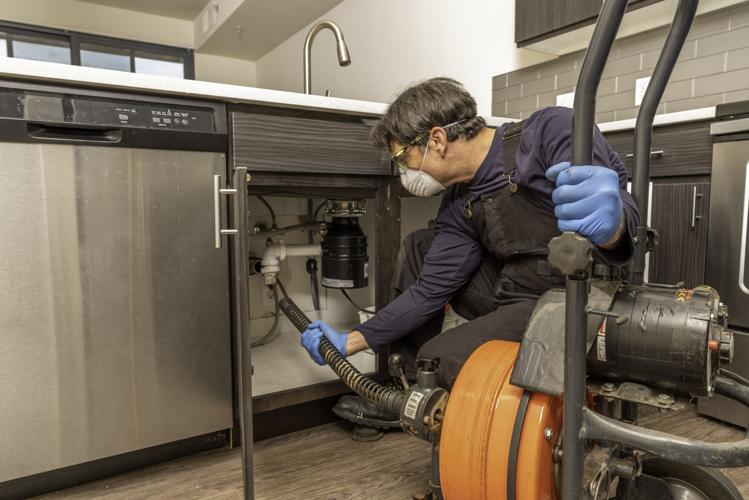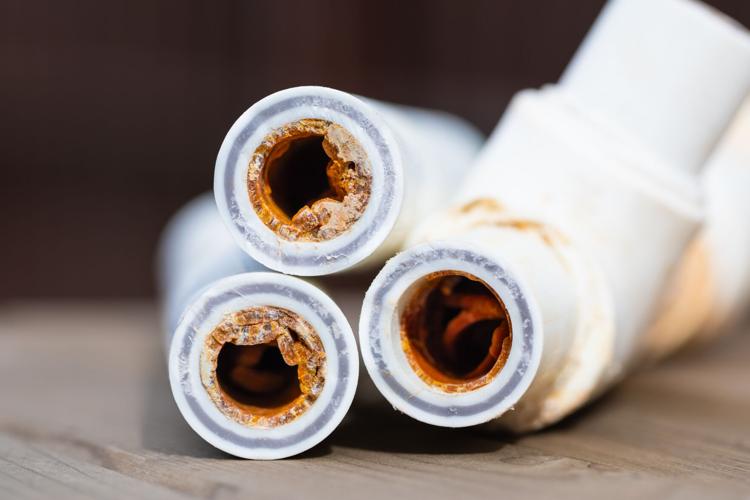
Drain cleaning by professional plumber wearing a safety mask, using an auger
There are many things in the home that people know to maintain regularly, from their gutters to their appliances and flooring. However, drains are not typically something that is considered. That is until they become clogged, smelly, or burst.
In reality, the condition of your drainage system is a very important aspect to consider when it comes to your house’s functionality. Drainage problems are both a safety and health hazard to your family. They can lead to damage in your house's concrete foundation, building material deterioration, and insect and rodent infestation. While it may not need to be part of your weekly cleaning routine, checking your drainage system periodically can help prevent many of these problems and save you money in the long run.
How do I know if I have drainage problems?
Drainage problems can be easily detected most of the time, especially with the help of a flow monitor. Any significant issues are usually discovered through the use of the affected drain. For example, blocked drains will become apparent if the water stops flowing down the sink. If the water still runs down the sink, albeit very slowly, you may be on your way to a blockage.
The first thing to do is find out the type of pipes you have running through your house. Drainage pipes come in different sizes, some of these include 82mm drainage, 110mm drainage, 160mm drainage, 200mm drainage, 250mm drainage, 315mm drainage, and 400mm drainage. Once you know the sizes, you can check whether your system is showing any symptoms and the sort of tools you may need to resolve them. There are several things your system might do to alert you of a drainage problem. Some of these symptoms are:
Backflowing Water
Backflow is foul-smelling or discolored water that’s pushed back into your house pipes through the drain, often due to a failure in your current system. This problem is usually caused by a significant change in water pressure in your system, allowing drain water to flow backward. This backflow water from the drainage system can contain sewage and be harmful to your health. Nowadays, most houses come pre-installed with backflow valves to keep this from happening. However, like most equipment, backflow valves can fail. If you notice back-flowing water or have concerns about the type of water coming through your pipes, you should contact a professional immediately to find where the problem is and replace the valve or any pipes necessary.
Nasty Smells
Drains shouldn’t be expected to smell good, but they also shouldn’t release any extremely pungent or nasty smells, either. Many homeowners spend way too much money on chemicals to help their drains smell better. Your drainage system helps remove wastewater from your property, so smells aren’t unusual. The most common place for unpleasant smells is your kitchen sink. This is because food can build up in and around kitchen sinks, enabling bad smells to be emitted. Generally, this can be easily fixed by cleaning your drain. But unfortunately, if you have nasty smells coming out of more than one drain, you might have a bigger problem on your hands and require professional help.
Thankfully, many companies like Hy-Pro Plumbing & Drain Cleaning and similar service providers assist homeowners with drainage problems. They have the experience, expertise, and skills that help them get the job done properly. Depending on the extent and severity of the drainage issues, they use high-quality, state-of-the-art plumbing tools and equipment to determine the root cause of the problem and look for ways to fix it immediately.
It's important to learn about water treatment options to know what to apply for a specific problem. There are many different options depending on the type of water source, whether it's well water or city water.
Strange Sounds
If you hear some strange sounds, it can be another sign you may be dealing with some drainage issues. For example, if you notice gurgling sounds from the drains and pipes, there can be a blockage that causes the water to clog your plumbing pipes.
Hence, if you encounter these sounds more often, call the professionals to check the drainage system for you. That way, they can figure out where the sounds are coming from and what causes them.
Problems When Using Plumbing Fixtures
Problems when using plumbing fixtures may also result from a major drainage issue. If the toilet water continues to bubble even after running water in the sink closest to the toilet, it can indicate a drainage problem. Also, there’s an issue with your drains if, after flushing the toilet, the water backs up from the tub.
So, if you experience these issues frequently, seeking professional assistance may be the best way to check the condition of your drainage system.

Slow-moving Water
Most people assume that drainage clogs build up overnight, as one day the drain works and the next it doesn’t. But most of the time, this isn’t the case. These sorts of problems tend to accumulate and worsen when left untreated or undetected. Drainage clogs develop when waste begins to stick and accumulate inside your pipes. Over time, more debris sticks to the walls, restricting water flow and once the mass of waste meets in the middle of your pipe, the clog is complete. That’s often when people discover they have a problem. Then, it has to be unclogged to get water flowing again. Thankfully, most drainage clogs are preventable. If you notice the water is draining slower than usual but still moving, there are several handy methods you can try to prevent it from clogging. Over-the-counter items that help or prevent clogs include a drain snake and a plunger.
If you notice your drainage system has any of these symptoms, or you attempt to fix it on your own without success, you might want to get it checked or tested by a professional.
There are two basic ways a plumber or specialist can test your drainage system. These include:
Air Test
The air test is considered the easiest to do, while still finding accurate results. It’s typically best run on single pipes and individual drain runs as although this method is effective, it can only be used to test drains that can be capped at both ends. Otherwise, it’s likely the results won’t be accurate. The air test is conducted by putting airtight plugs on both ends of the system being checked. Using a drain pressure gauge, the pressure is set to 110mm per head for five minutes, then adjusted to 100 mm per head. After five minutes, any change in the head is recorded. Typically, the maximum loss allowed is 5 minutes. If any more, then there’s likely a problem with the drainage system.
Water Drop Test
The water drop test is a more complex method that’s used to test a complete drainage system, right down to the chambers and gullies. It works by isolating the downstream end of a drain, before filling the system with water and monitoring water levels at a manhole or pipe access point. For this type of test, any drop less than 25mm in 10 minutes is acceptable.
Checking your drainage system regularly, and doing regular maintenance work can prevent your clogging. When left unmaintained, clogged drainage systems can be a money pit, and even cause structural damage to your home. While they’re easy to overlook, it's crucial you stay on top of any problems you notice in your drainage system. Early detection of issues, thanks to strange smells or backwater, will allow you to fix a problem before it escalates. As tempting as it may be, ignoring small problems can lead to bigger ones later, and you may have to replace the whole system if you’re not careful. If you're experiencing water buildup or poor runoff, our expert drainage services in Kitsilano can solve the problem quickly and efficiently. Our experienced team provides comprehensive drainage services Vancouver, ensuring efficient water management for residential and commercial properties.





(0) comments
We welcome your comments
Log In
Post a comment as Guest
Keep it Clean. Please avoid obscene, vulgar, lewd, racist or sexually-oriented language.
PLEASE TURN OFF YOUR CAPS LOCK.
Don't Threaten. Threats of harming another person will not be tolerated.
Be Truthful. Don't knowingly lie about anyone or anything.
Be Nice. No racism, sexism or any sort of -ism that is degrading to another person.
Be Proactive. Use the 'Report' link on each comment to let us know of abusive posts.
Share with Us. We'd love to hear eyewitness accounts, the history behind an article.